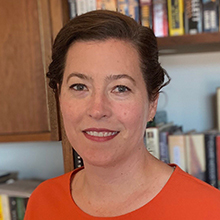Young Children Need (More) Science Education
By Megan Silander, Ph.D.
Posted on 2025-09-10

Disclaimer: The views expressed in this blog post are those of the author(s) and do not necessarily reflect the official position of the National Science Teaching Association (NSTA).
Anyone who spends time with young children knows they ask a lot of questions. Why do birds make nests? Why does water look green sometimes? Why do bug bites itch? These questions show children’s direct connection to and curiosity about the world around them. Preschool children can ask between 70 to 200 questions each hour of their day (Chouinard et al., 2007). Almost three-quarters of those questions are asking for information about the world: mostly requesting facts, but also explanations for how the things children encounter daily work. Young children engage in scientific exploration by observing, asking questions, investigating, and documenting. However, many do not get the chance to engage in this range of activities because families and educators are unsure of how to support young children’s science explorations, and early elementary educators are rarely provided with the support and resources they need to engage early learners in productive science activities. As a result, most children do not get enough opportunities to learn science in the early grades (NASEM 2022).
The delight that young children show for science is unmistakable, but for many, this interest wanes by the time they reach middle school (Maltese and Tai 2011). Some research attributes this decline to the lack of early opportunities for participating in meaningful and engaging science experiences (NASEM 2022). Children face differential access to these early science opportunities, and as a result, bring different levels of experience with doing science when they start kindergarten. Children with less science experience and knowledge than their peers in kindergarten are more likely to remain behind in middle school because of factors such as under-resourced schools (Morgan et al., 2016). Furthermore, the same children who had lower levels of science knowledge in kindergarten also tended to fall behind in reading and math over time. Although many people feel that children must master the “basics” before they learn science (Volmert et al., 2013), there is strong evidence that science instruction boosts reading comprehension for all students (Kim et al., 2023). Specifically, English language arts programs that include science and social studies content have shown strong potential to improve reading comprehension in the early grades (Cabell and Hwang 2020; Gray et al., 2022). Our challenge is to ensure all children have access to high-quality science experiences in the early grades to build a solid foundation for successful science learning experiences as they progress through secondary education and enter the workforce.
CAESART: Addressing the Lack of High-Quality Science Assessments
To support this aim, the Center to Advance Elementary Science through Assessment, Research, and Technology (CAESART) is focused on creating reliable and valid science assessments for young learners. This task may seem narrow, but it supports a much bigger goal: To improve science education for young children, we need to know whether and what they are learning. Tracking student learning and how it varies is essential to improve science instruction by revealing how learning is influenced by factors such as instructional time, curriculum, professional development, and other supports. To identify and understand what works in science education, we need valid, reliable, and fair assessments for young learners. Addressing this issue is at the heart of CAESART’s work, along with exploring how technology can assist in developing better assessments.
Although many science assessments have been created by teachers, curriculum developers, and science materials publishers, none offer a means to assess learning in a consistent and reliable way. Additionally, most state and national science assessments in the United States are not designed for children below fourth grade. One reason these kinds of assessments do not exist is that measuring student understanding in the early grades presents multiple challenges. A particular challenge is that young children learn science practices and build knowledge in ways that do not require reading or writing, as many young learners are still acquiring these basic skills.
What Our Research Center Does
CAESART has started this work by conducting a systemic review of existing science assessments for prekindergarten through fifth grade. Once complete, we plan to share this information through a publicly accessible database that researchers, administrators, and policymakers can use. This work is important because many existing assessments are not widely known, hard to find, or not clearly documented. By gathering this information in one place, we can help others identify existing tools, the age groups they target, the NGSS constructs covered, and where the biggest gaps in available assessments remain.
Second, CAESART is leading a series of measurement studies to create new science assessments for young learners.
- The University of Miami’s Lens on Science (“Lens”) team developed a computer-adaptive science assessment for preschoolers that adjusts items in real time to align with student responses, reducing the number of test items per child and minimizing child drop-off in engagement. The Lens team is expanding this assessment to kindergarten, first, and second grade. Because Lens is an adaptive assessment, it can provide a more accurate picture of what students know, without overwhelming them with questions that are too easy or too hard. This approach accommodates a young child’s short attention span, resulting in a more accurate reflection of children’s knowledge.
- The research team at UCLA’s CRESST (National Center for Research on Evaluation, Standards, and Student Testing) is designing digital game-based performance tasks aligned with the NGSS. Assessing students’ three-dimensional science learning during problem solving is complex. Performance-based and constructed response assessments can capture this complexity, but these types of assessments often depend on students’ reading and writing skills and require 1:1 adult –child administration as well as time-consuming scoring. CRESST’s newly developed tasks will give children a chance to show their science understanding by engaging in activities that reflect real scientific practices, such as asking questions, making observations, and interpreting data related to physical science concepts.
Together, these efforts will give researchers and educators better tools to measure what young children know and can do in science.
Using Our Assessments to Test Approaches to Improving Science Learning
The assessments are useful only in their ability to help us understand how to improve science learning. CAESART will investigate the effects of an integrated science and literacy curriculum using the assessments developed by the Lens and CRESST teams. This study will provide insight into the feasibility of using these assessments in a large-scale experimental study, and for improving elementary science learning.
Specifically, this study offers an opportunity to examine solutions to two core challenges in improving young students’ science learning: (1) lack of instructional time for science, and (2) limited availability of curricular materials aligned to NGSS. Educators in early elementary classrooms are under pressure to focus on math and literacy, often squeezing out time for science instruction (NASEM 2022), and educators often lack access to high-quality early elementary science resources and materials, as well as professional support for their use. The study rests on the hypothesis that integrating a high-quality, NGSS-aligned science curriculum with an early literacy instructional focus has the potential to both increase time spent on science and support students who lack the background knowledge or vocabulary needed to fully engage in science learning.
EDC (Education Development Center) is partnering with staff from Lawrence Hall of Science, who developed the integrated science and literacy curricula that will be of focus for the study, and who will design the professional learning to support use of the curricula. Our study will investigate how an integrated science-literacy curriculum increases time spent on science, and whether providing teachers with access to that curriculum and materials increases student science and literacy learning, compared with a typical science curriculum. It will simultaneously provide the large-scale implementation opportunity needed to demonstrate the effectiveness of the CAESART assessments now under development.
What We Hope to Learn
Our work will show how we can improve science teaching and science assessment in the early grades, what students understand, what they struggle with, and what we need to focus on to give all children more opportunities to learn science.
Assessments provide our initial focus, but our goal is much bigger: to create current and future generations of children who are prepared for and able to engage in science from their early academic experiences through schooling and into the workforce.
To learn more about our work, visit https://caesart.edc.org/.
References
Cabell, S. Q., and H. Hwang. 2020. Building content knowledge to boost comprehension in the primary grades. Reading Research Quarterly 55 (S1): S99–S107. https://doi.org/10.1002/rrq.338.
Chouinard, M. M., P. L. Harris, and M. P. Maratsos. 2007. Children's questions: A mechanism for cognitive development. Monographs of the Society for Research in Child Development 72 (1). http://www.jstor.org/stable/30163594.
Gray, A. M., P. M. Sirinides, R. E. Fink, and A. B. Bowden. 2022. Integrating literacy and science instruction in kindergarten: Results from the efficacy study of Zoology One. Journal of Research on Educational Effectiveness 15 (1): 1–27. https://doi.org/10.1080/19345747.2021.1938313.
Kim, J. S., M. A. Burkhauser, J. E. Relyea, J. B. Gilbert, E. Scherer, J. Fitzgerald, D. Mosher, and J. McIntyre. 2023. A longitudinal randomized trial of a sustained content literacy intervention from first to second grade: Transfer effects on students’ reading comprehension. Journal of Educational Psychology 115 (1): 73–98. https://doi.org/10.1037/edu0000751.
Maltese, A. V., and R. H. Tai. 2011. Pipeline persistence: Examining the association of educational experiences with earned degrees in STEM among U.S. students. Science Education 95 (5): 877–907. https://doi.org/10.1002/sce.20441.
Morgan, P. L., G. Farkas, M. M. Hillemeier, and S. Maczuga. 2016. Science achievement gaps begin very early, persist, and are largely explained by modifiable factors. Educational Researcher 45 (1): 18–35. https://doi.org/10.3102/0013189X16633182.
National Academies of Sciences, Engineering, and Medicine. 2022. Science and engineering in preschool through elementary grades: The brilliance of children and the strengths of educators. Washington, D.C.: National Academies Press. https://doi.org/10.17226/26215.
Volmert, A., M. Baran, N. Kendall-Taylor, and M. O’Neil. 2013. Mapping the Gaps Between Expert and Public Understandings of STEM Learning. Washington, D.C.: Frameworks Institute. Megan Silander, Ph.D., leads national initiatives and studies that generate new insights into effective preK–12 education policies and programs. Currently, she is leading the Center for Advancing Elementary Science through Assessment, Research, and Technology (CAESART) at EDC, an initiative that is generating innovative ways to understand children’s science learning and applying this new knowledge to improving elementary science education.
Megan Silander, Ph.D., leads national initiatives and studies that generate new insights into effective preK–12 education policies and programs. Currently, she is leading the Center for Advancing Elementary Science through Assessment, Research, and Technology (CAESART) at EDC, an initiative that is generating innovative ways to understand children’s science learning and applying this new knowledge to improving elementary science education.
The mission of NSTA is to transform science education to benefit all through professional learning, partnerships, and advocacy.


